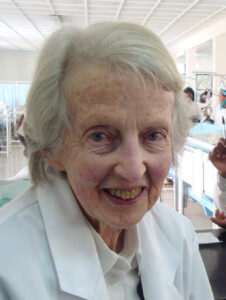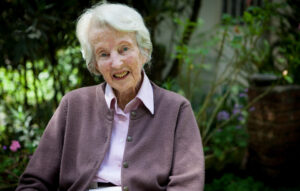“I’m trying to wake the world up”
Born in a big family in Sydney, Australia, in 1924, Catherine Hamlin attended college in her hometown and graduated from The University of Sydney School of Medicine in 1946. After completing her studies, she went on to work as medical officer at the Crown Street Women’s Hospital in Sydney, where she met her future husband, Dr. Reginald Hamlin.
After getting married, driven by their passion to help others, the young couple didn’t hesitate long before accepting a contract with the Ethiopian Government to work as obstetrician gynecologists and set up a midwifery school in Addis Ababa. Thanks to their compassionate and adventurous spirit, what was supposed to be a three-year work assignment has turned into a life-long mission.
“I believe God guided Reg and me to Ethiopia. We were searching for more fulfilling work in a developing country and we answered an advertisement in The Lancet medical journal for gynecologists needed in Addis Ababa. It was to set up a school of midwifery. We had no idea this opportunity would lead to our life’s work,” says Dr. Catherine Hamlin. Arriving in Ethiopia for the first time over 60 years ago, Catherine and Reg were warned by a fellow gynecologist that “the fistula patients will break your hearts.” And they did.
An obstetric fistula is a hole between the birth canal and the bladder or rectum. This painful and humiliating internal injury caused by an obstructed labor during childbirth can leave a woman incontinent, ostracized and often cut off from her community.
When the Hamlins came to Ethiopia, there was little or no treatment available to local women with this condition, and the Australian couple have never even seen an obstetric fistula case before, but they immediately jumped into action. “We were touched and appalled by the sadness of our first fistula patient: a beautiful young woman in urine-soaked ragged clothes, sitting alone in our outpatient’s department, away from the other waiting patients. We knew she was more in need than any of the others,” recalls Catherine.
Initially based in the Princess Tsehai Memorial Hospital in Addis Ababa, Catherine and Reg refined the surgical technique to close obstetric fistula injuries, while continuing to treat a broad range of obstetric cases. Within the first three years, Reg and Catherine had operated on 300 fistula patients. As news of a cure spread, many more women came seeking treatment.
On top of the mammoth challenges the Hamlins were dealing with, living in Ethiopia at the time could be quite dangerous, too. In 1960, during a coup attempt by the head of the imperial bodyguards, Catherine was in the labor ward delivering a baby, when she heard gunfire. Some bullets flew past the window where she was working. Unfazed, Catherine continued to do her job, focused solely on the patient.
In 1974, after successfully raising the funds, they opened a dedicated hospital for fistula patients – the Addis Ababa Fistula Hospital. In addition to that first one, five regional hospitals have since been established for fistula surgery. All six also provide a safe birthing facility where former patients can return to for a clean, safe caesarean section delivery, free of charge.
From the very beginning, Catherine and Reg set the world’s best-practice standards of patient care and hygiene for women with obstetric fistula, and Catherine personally went above and beyond to comfort the patients. She held their hands during check-ups, she soothed the nervous ones before surgeries and cheered up those not yet cured with the quiet, calm demeanor that she is known and loved for. Dr. Hamlin even made the gowns for the operating theatre and the sheets for the beds on her personal sewing machine.
She recalls a day in May 1991 when there was unrest on the streets outside the hospital. Dr. Hamlin was at home, knitting, when the telephone suddenly rang. She got up off the sofa and went to answer. As she did so, a bullet came in through the roof and hit a cushion where she had been sitting. “God was with me in difficult times,” smiles Catherine.
When Dr. Reg Hamlin passed away in 1993, Catherine faced a hard decision. She and Reg had set up the hospital, made future plans, and faced countless obstacles together. The idea of going on alone was overwhelming. No one would have thought less of her for leaving Ethiopia. With the hospital functioning flawlessly, she could have retired at 69, having already made a huge difference to thousands of women.
“I began to realize the enormous blessings that I had, and the future seemed suddenly bright. This is my home and these people are my family,”
Many people would have returned to Australia, but Catherine stayed. “I began to realize the enormous blessings that I had, and the future seemed suddenly bright. This is my home and these people are my family,” says Catherine in her autobiography “The Hospital by the River,” first published in 2001.
Surrounded and comforted by her Ethiopian family and friends, she carried on, as new patients from all over the country continued to arrive at the hospitals. Some walked for days to reach Hamlin Fistula Ethiopia; others borrowed money or begged to raise the bus fare, praying they will be allowed to board despite their smell. Once they made it to Hamlin, they knew they were safe. Through power outages, water shortages and political upheaval, Catherine persevered. As a result of her staying, Hamlin Fistula Ethiopia has operated on thousands of Ethiopian women to repair their fistula injuries and restore their dignity.
Today, Hamlin Fistula Ethiopia is a healthcare network with six Hamlin Fistula Hospitals, Desta Mender Rehabilitation Center (“Joy Village” in Amharic), the Hamlin College of Midwives and 80 midwifery clinics, all supported by the Catherine Hamlin Fistula Foundation. The staff of over 550 Ethiopians continue Catherine’s dream of transforming women’s healthcare throughout Ethiopia. “I am thankful to have great staff. The future of our hospitals are in good hands,” says Catherine.
“I’m still trying to wake the world up and tell people about the women we treat. It warms my heart that so many people have supported our work,” notes Dr. Catherine Hamlin. “To see a girl from abject poverty and sadness and sorrow suddenly become a new person, that’s the joy that fistula surgeons get when they cure them. I just love these women. My feeling for them, my compassion for them, is unending.”
“My dream is to eradicate obstetric fistula. Forever. I won’t do this in my lifetime, but you can in yours.”



